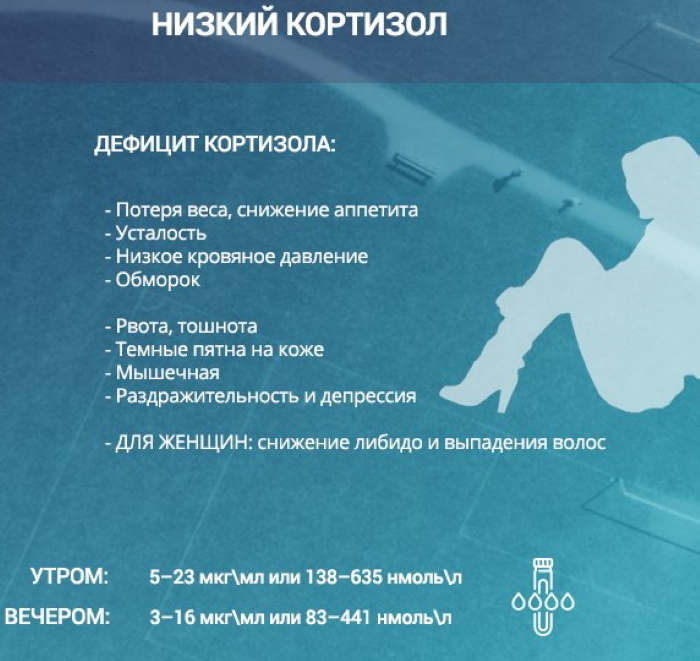The temporomandibular joint is a bone with cartilage, holding the lower jaw with the base of the skull.
This bone is a paired nodule, since the movement of the head from the left side will not occur without movement of the head from the right side. Such a bone structure can be subject to various kinds of pathologies and dysfunctions. The anatomy, structure, and function of the temporomandibular joint can be found below.
Record content:
- 1 Temporomandibular joint anatomy
- 2 Structure and function
- 3 Causes of diseases
- 4 Dysfunction symptoms
- 5 Diagnostics
-
6 Treatment
- 6.1 Medication
- 6.2 Folk remedies
- 7 Temporomandibular joint anatomy video
Temporomandibular joint anatomy
Temporomandibular joint (the anatomy is externally closed due to strong masticatory muscle fibers that carry out the main jaw movement) with the interaction of all its components is concentrated in the implementation of physiologically important movements, namely: closing and opening the mouth.
Due to this, a person is able to perform a huge amount of actions: from vocal and to chewing functions. Therefore, TMJ plays an active role in improving human life.
This bone structure is placed on the cranial base, where a huge number of other anatomical structures are concentrated. Therefore, its structural elements are very miniature and do not provoke a failure in the activity of a huge number of vessels, hearing organs and nerves.
The temporomandibular joint is difficult because it is surrounded by soft tissues that control various functions in the body.
The structure of the temporomandibular joint must necessarily be considered from 2 sides, since the joints always function identically.
Characteristics of the main features of the temporomandibular joint:
| Peculiarities | Short description |
| TMJ is characterized by a complex structure of the compound | For this reason, bone structures lack common points of contact. Between them is a cavity filled with a cartilaginous and fibrous disc. The latter makes it possible to increase the volume of some movements. |
| By location, the bone structure belongs to the cranial joints | It is they who form the direct connection of the facial section with the base. Despite the fact that the temporal bone has its own characteristic features, it takes part in the formation of both the vault and the base of the skull. |
| The joint may belong to the combined | During the contraction process, the articular muscles function identically. One-way traffic can manifest itself only with dislocations or fractures. |
| The joint is presented in the form of an ellipse | Due to this, the convex process of the lower node is able to interact with the round and concave surface of the joint. Since their contact is not limited, a person is able to perform a huge range of various movements. |
Structure and function
The temporomandibular joint, the anatomy and structure of which has been fully studied by medical specialists, is described in the following paragraphs:
- tubercle of the upper jaw;
- upper and lower head of the lateral pterygoid muscle;
- branch and head of the lower jaw;
- articular hump;
- the crest is infratemporal;
- articular disc;
- coronary process;
- the process is subulate;
- external auditory passage;
- submandibular ligament;
- joint capsule and tubercle;
- mandibular fossa.
This muscle joint has a pair located on the other side of the skull. Classify it as a combined knot. The upper part of the node includes the bony heads of the lower jaw and the temporal bones.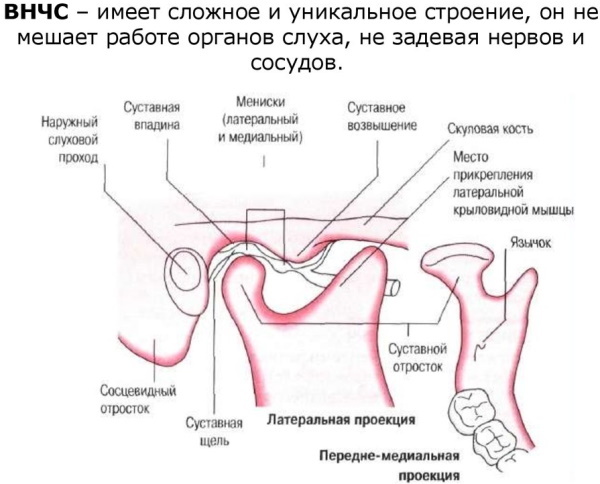
The fossa is concave inward, there is a characteristic tubercle protruding and protecting the medial wall. All this is called the surface of the TMF node. They have a distinctive shape and increased functionality, slightly tilted forward in relation to the necks.
The node is necessary for the following functions: pronunciation of speech, chewing and absorption of food, as well as for performing movements in different directions.
Possesses the following functional characteristics:
- thanks to complex and specific reflectors, the parallel work of the movements of the lower jaw is carried out (this is necessary for closing teeth, chewing and performing other tasks);
- has a complex mechanism that is involved in the movement of the jaw and transmits neuroimpulses to the central nervous system;
- the joint is formed from 2 connecting components of an identical structure (their movements are performed synchronously, and in case of violation of the simultaneous sequence, the node disease sets in).
The main characteristic feature of the structure of the TMJ is the parallel and synchronous work of the muscles. The motor functionality is exactly the same on each side.
The muscle groups surrounding the TMJ are described in the following list:
- temporal;
- double abdominal;
- chewing;
- lateral pterygoid;
- medial pterygoid;
- chin-sublingual;
- maxillary-hyoid.
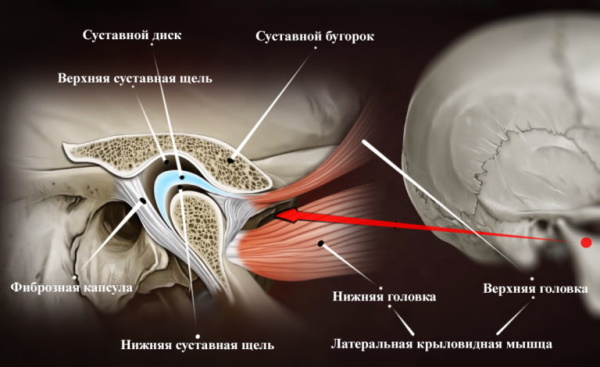
The muscles located on the lower jaw are involved in the movement of the structure. The number of movements is limited by the muscles, and certain motor functions are influenced by the types of articular surfaces and connective tissues.
Controls the activity of the chewing muscles of the central nervous system. They perform the main load during the period of activity of the lower jaw, and periodontal receptors are involved in the management of the TMJ muscles. It is thanks to this that the minimum, but evenly resisting load is carried out from 2 sides.
Causes of diseases
The temporomandibular joint, the anatomy of which is not protected from various diseases, can have pathologies for the following reasons:
- predisposition at the genetic level;
- high physical activity;
- infection and stress;
- disruption of the temporomandibular joint, which arose after surgery;
- pathologies caused by abrasion of the tooth surface;
- bite pathology;
- injury to the jaw joint;

- extremely hard food.
Sharp, sharp, cutting or stabbing pain indicates joint inflammation. The pain always increases if the jaw performs any action, and this affects human activity.
Painful sensations can be transmitted to adjacent tissues of the head. This spread is due to the fact that different parts of the head and jaw are innervated by the same nerve. As a result of the transmission of pain impulses from the jaw joint, a person can perceive such pain, for example, for a headache.
Described by patients as aching and pulling pain in most cases is caused by chronic inflammation. Pain is permanent or appears as a result of stress on the joint. In this case, the function of the joint may be limited and the patient will not be able to open his mouth by more than 2 cm.
The temporomandibular joint has the following classified pathologies:
- a disease associated with dysfunction of the masticatory muscles;
- dysfunction of the morphological and functional nature of the inner part of the joint;
- acquired diseases, as well as anomaly of the TMJ.
The following problems are responsible for disruption of the masticatory muscles:
- an increase in some chewing muscles;
- inflammation;
- restriction in muscle movement;
- musculo-articular dysfunction.
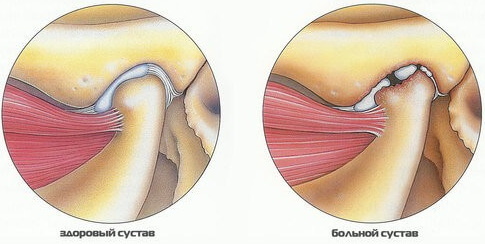
Disorders of the inner part of the joint of a morphological and functional nature are caused by the following diseases:
- ankylosis;
- displacement of the disk of the unit with reduction;
- displacement of the head of the joint;
- inflammatory processes of the tissues of the articular capsule, posterior zone, synovial membrane;
- the presence of hypermobility of the head of the joint;
- articular disc and head are incorrectly located;
- perforation and thinning of the disc;
- separation of the articular discs from each other and the head;
- articular disc prolapse.
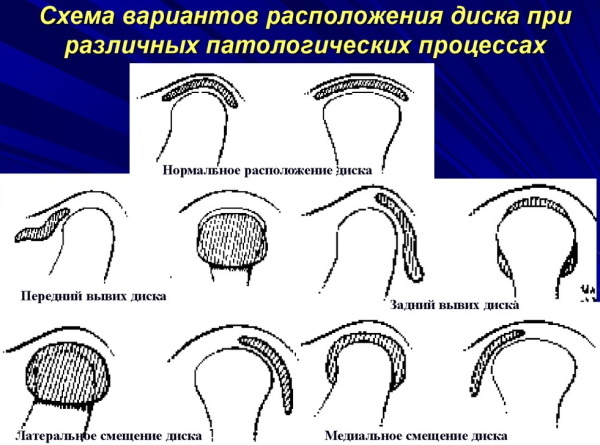
TMJ ailments and abnormalities:
- hyper- or hypoplasia, aplasia of two or one head of the joint;
- asymmetry of the TMJ in relation to the cranial base;
- neoplasms of the joint or adjacent formations with expansion to the node;
- joint pathologies that are closely intertwined with blood disease, systemic scleroderma and rheumatoid arthritis.
Dysfunction symptoms
The temporomandibular joint, the anatomy of which is characterized by increased complexity, has a very strong effect on human life.
Symptoms of dysfunction of the bone structure may include the following sensations:
- dizziness;
- depressive state;
- unusual sounds that come from the jaw in the form of creaking, popping, clicking, grinding and crunching;
- swelling of the facial area;
- poor appetite and sleep;
- increased body temperature for a long period of time;
- squeezing, as well as restraint in the process of closing or opening the jaw;
- weak hearing;
- Difficulty talking or chewing food
- increased pain that can radiate to the gums, teeth, head and ears;
- noise in ears.
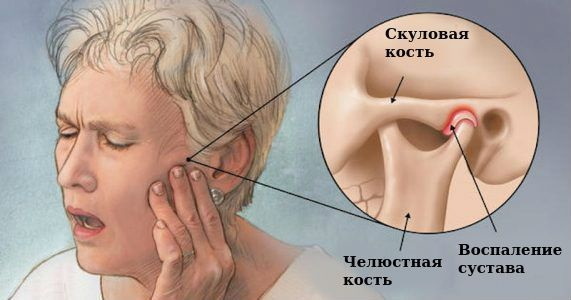 During the period of therapeutic therapy for dysfunctions associated with TMJ, patients are advised to reduce the load on the node, which consists in limiting speech, using exclusively liquid and soft foods. To reduce or reduce the sensation of pain, physiotherapy procedures, massage, various drugs, intra-articular injections and blockade are mainly prescribed.
During the period of therapeutic therapy for dysfunctions associated with TMJ, patients are advised to reduce the load on the node, which consists in limiting speech, using exclusively liquid and soft foods. To reduce or reduce the sensation of pain, physiotherapy procedures, massage, various drugs, intra-articular injections and blockade are mainly prescribed.
To create the correct bite, it is imperative that you undergo treatment with a dentist. Most patients go to biofeedback therapy and psychotherapy, where they learn to relax the chewing muscles.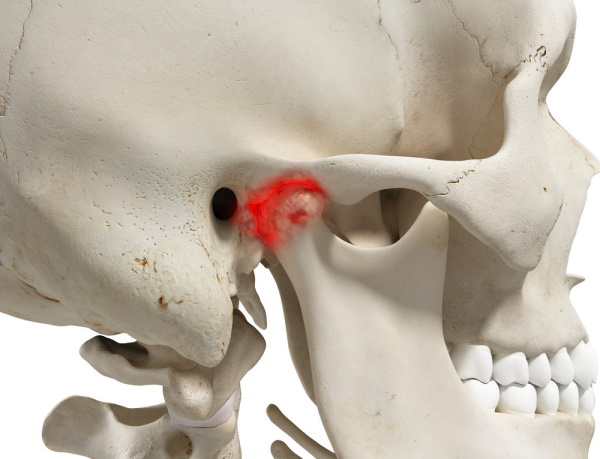
To cure various pathologies of the node, it is recommended to adhere to the balancing of the temporomandibular joint. This procedure makes it possible to relax the articular muscles without the use of tools, painful procedures and external interventions. This process is carried out by a specialist using a special relaxing technique.
Diagnostics
The anatomy of dysfunctions requires the correct determination of the diagnosis when pathologies associated with problems of the temporomandibular joint are detected. The specialist must palpate and identify where exactly the pain occurs in the patient. He, in turn, is obliged to describe in detail his symptoms and complaints so that the dentist can determine the initial cause of such violations.
After that, the doctor may prescribe the following diagnostic procedures:
- analysis of blood and urine (examination data allow you to get acquainted with the general picture of the patient's health, as well as identify inflammatory processes that are present in the body);
- gnatodynamometry;
- dopplerography;
- MRI (this procedure accurately describes the problem, therefore it is prescribed when discomfort in the area joint in the form of a small amplitude of jaw movement, discomfort when chewing, numbness and occurrence clicks);
- orthopantomography;
- X-ray (the resulting pathology will be noticeable in the picture, thanks to which the doctor will prescribe the appropriate treatment, as well as prescribe the patient procedures related to the correction of the joints);
- electromyography.
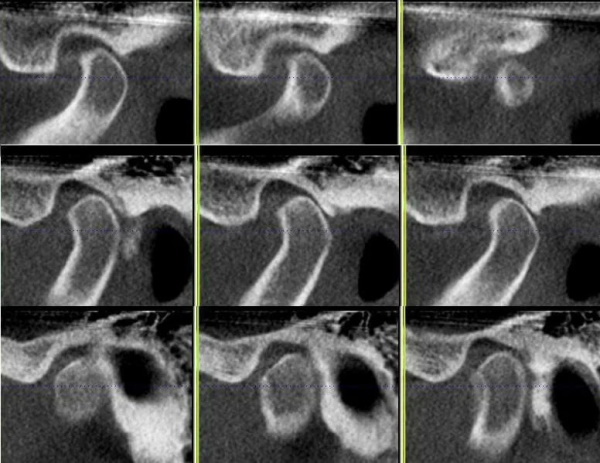
For the treatment of pathologies associated with TMJ, you can contact the following specialists:
- infectious disease specialist;
- ENT;
- neurologist;
- orthopedist;
- psychotherapist (if you need to perform personal correction);
- rheumatologist;
- dentist;
- therapist;
- traumatologist;
- phthisiatrician (if there is a suspicion of tuberculosis);
- surgeon.
Initially, you need to consult with a therapist. After that, he will determine a highly specialized specialist who is able to eliminate the pathology, as well as determine the root of the disease. The dentist will be able to correct the wrong bite, and the infectious disease specialist will be able to get rid of the infectious pathology.
If the first signs of the disease appear, it is recommended to immediately consult with a specialist. In case of untimely treatment, dire consequences are possible. It is advisable to cure the disease at the initial stage, until it begins to develop and does not bring much more problems.
Treatment
Therapeutic treatment of TMJ pathologies is a multifaceted and difficult task that requires professionalism and excellent the qualifications of medical specialists, as well as their literacy in the field of modern diagnostics and methods of treatment.
Modern therapy of the temporomandibular joint is based on the involvement of doctors of various specializations, as well as their reasonable and well-coordinated cooperation so that the patient does not waste time visiting the hospital with a large number of unnecessary tests, thereby losing hope for a positive result.
Medication
When the doctor has eliminated the symptoms of the disease, the TMJ is treated as described in the following points:
- Antibiotics are prescribed without fail if a patient is diagnosed with purulent arthritis. Before this, the doctor must perform a sensitivity test.
- It is not recommended to take analgesics on your own, since only a doctor can select them individually for each patient.
- To relieve inflammation and eliminate pain, the attending physician may prescribe a novocaine blockade or anesthetic.
- Gels and ointments based on bee venom will help to cope with edema and inflammation. In this case, compresses can be applied along with them. The most important thing is that the compress should not be made without the recommendation of the attending physician, otherwise it can only aggravate everything. In the case of self-medication, it is worth remembering that, for example, with purulent arthritis and applying a warm compress, this will only provoke the multiplication of bacteria.
In the absence of the possibility of treating the temporomandibular joint with medication, the doctor may prescribe a treatment that is based on surgical intervention.
Folk remedies
Folk remedies can remove inflammatory symptoms, reduce pain, and simplify the course of the disease. However, folk recipes are unable to completely get rid of the pathology that has arisen.
To cure TMJ inflammation, you can use the following remedies:
- infusion based on burdock root;
- infusion of yarrow;

- propolis tincture;
- herbal collection.
To make a herbal collection, you will need to do the following:
- It is necessary to grind and mix 100 g of willow bark with 80 g of birch leaves and 20 g of black elderberry flowers.
- Then 5 tbsp. l. the composition should be poured with a liter of boiling water and insisted for 3 hours.
- Collection in the amount of 100 ml is required to be consumed three times a day before meals. It has antibacterial, anti-inflammatory and analgesic effects.
To make an infusion based on burdock root, you must adhere to the following points:
- 1 tbsp. l. of the ground root, it is required to steam 400 ml of boiling water, insisting about 3 tsp.
- The infusion must be filtered.
- Three times a day, raw materials should be taken in 2 tbsp. l. The infusion is characterized by analgesic and anti-inflammatory effects.
Making an infusion of yarrow is based on the following steps:
- 2 tbsp. l. dry ground herbs will need to be poured with a glass of boiling water.
- When the composition cools down, it needs to be filtered.
- The infusion must be consumed 3 times a day, 50 ml. It is characterized by anti-inflammatory action.
When creating a propolis tincture, you should adhere to the points below:
- 100 g of propolis is required to pour 500 ml of vodka and insist in the dark at room temperature.
- After 21 days, the composition will need to be filtered. The drug is taken twice a day, 10 drops.
The anatomy of the temporomandibular joint determines that such a bone structure, like any other system in the body, can be characterized by various pathologies or dysfunctions.
However, they can be accompanied by inflammatory and chronic pain, which cause discomfort. Therefore, when the first painful sensations appear in the jaw area, it is recommended to immediately contact the appropriate specialist for help.
Temporomandibular joint anatomy video
Temporomandibular joint:

